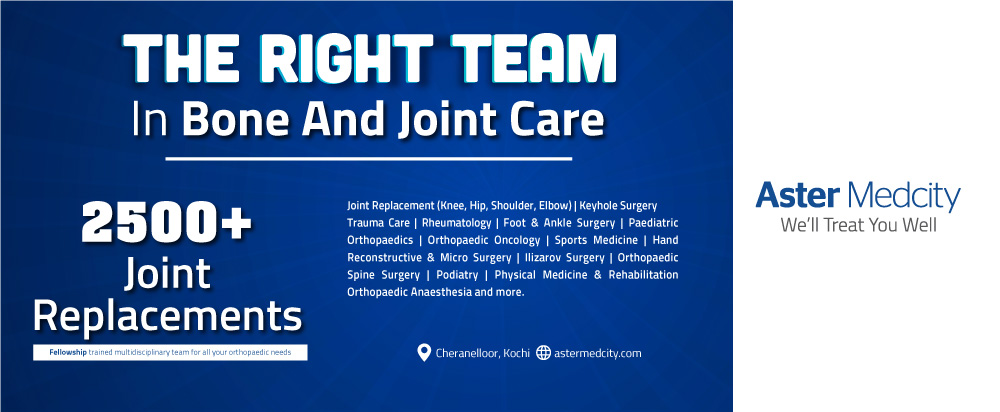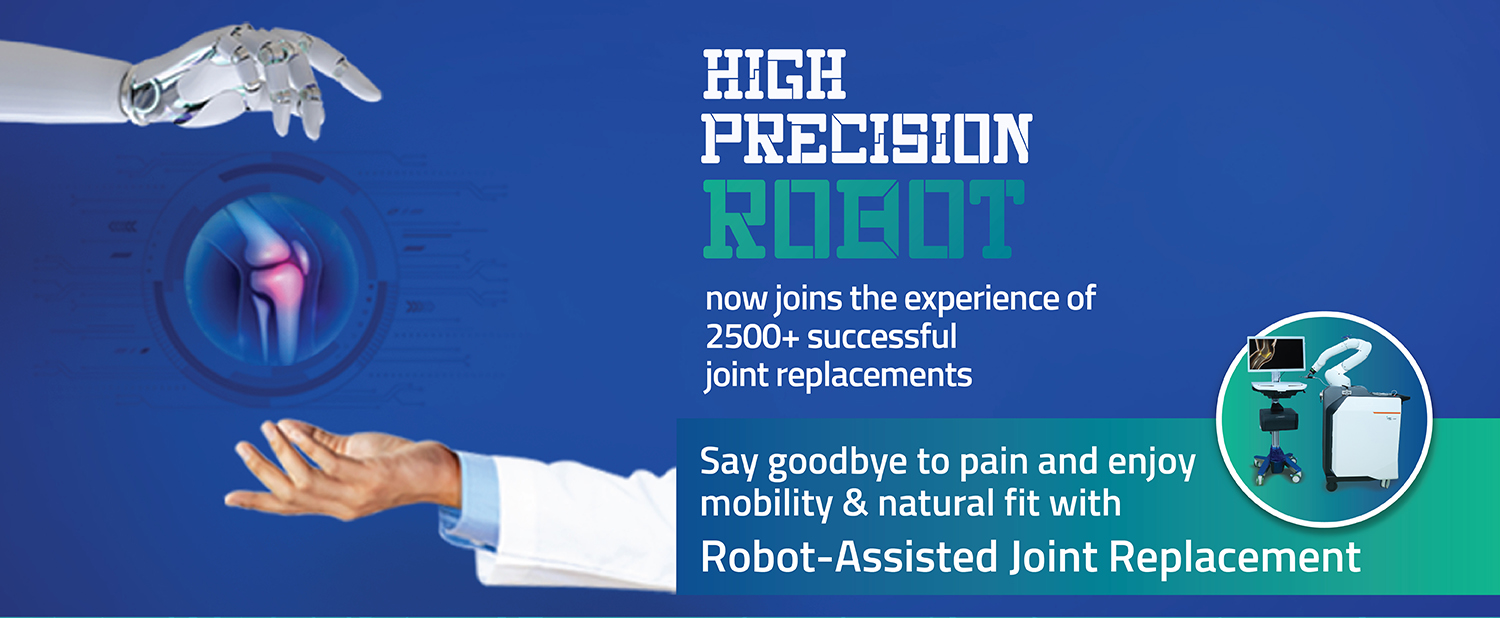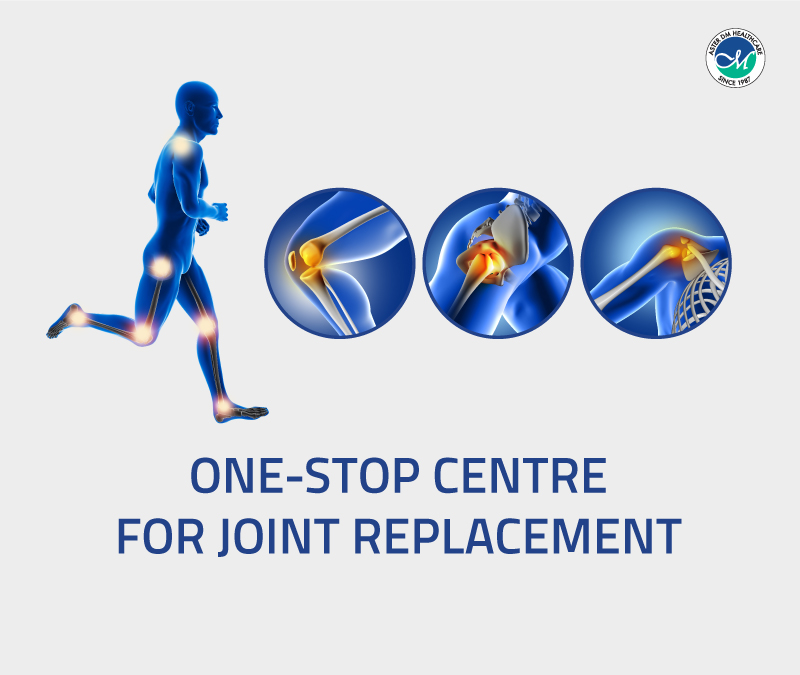ASTER CENTRE FOR JOINT REPLACEMENT
The Centre for Joint Replacement Surgery is one of the very few centres in the region that offers complete spectrum of surgical solutions to people suffering from joint pain problems. Headed by the qualified and experienced joint replacement surgeon, the centre is equipped with latest technologies that ensure utmost patient’s outcomes and faster recovery.
Osteoarthritis is the most common form of joint disease and the pain it causes is severe and can last lifelong. It was earlier seen especially among older people over 50 years, but now more and more young people are falling prey to osteoarthritis. The most commonly affected joints are knees, hips, shoulder, elbow, big toes and spine.
Pain in joints, tenderness in joints when applying pressure, stiffness in joints after sleep or after rest, swelling in joints, loss of flexibility and inability to move joints, a grating sensation when the joint moves are some of the mostly expressed symptoms by people with Osteoarthritis.
At Aster Centre for Joint Replacement Surgery, we adopt patient-centric treatment approach. Our expert clinical team who comes with the cumulative experience of 50+ years evaluates the patient’s history and present conditions thoroughly. After having a detailed counselling with the patient and the family, we chalk out the customized treatment plan.
WHY ASTER MEDCITY
We'll Treat You Well - This promise sums up why we exist. This promise is what we strive to honour every day, every moment.
We Believe In The Aster Experience - This is what helps us deliver our promise. This is what sets Aster apart. This is what makes you journey through any Aster environment smooth, efficient, and productive.
We Believe in Designing Hospitals That Heal Faster - Our hospitals are designed based on inputs and insights from patients by specialised architects with the clear intention of creating a soothing, spacious, uncluttered, warm, caring ambience that puts our patients instantly at ease.
Our centre is one of the very few in Kerala to offer wide range of joint replacement surgeries under one roof.
The department offers extensive in-depth diagnostics, medical and surgical treatment for various types of musculoskeletal disorders in adults and children.
Highly qualified and experienced team of surgeons: Our team of experts specialize in all sorts of joint replacement surgeries and have documented excellent patient outcomes
Advanced and customized surgical techniques: Our patient centric approach, minimally invasive joint replacement surgical techniques, computer navigation system, and the deployment of latest implants produce optimum outcome and rapid recovery
A joint care coordinator: We deploy a dedicated person who educates the patients and their family, and monitors the patient’s progress from pre-op counselling to post-op care

Total knee replacement, also known as total knee arthroplasty, is a surgical procedure used to treat severe knee joint damage and relieve chronic knee pain that cannot be effectively managed with conservative treatments. It involves replacing the damaged or worn-out parts of the knee joint with artificial components.
Total knee replacement is most commonly used to help people with severe osteoarthritis of all three compartments of the knee regain a normal lifestyle. It offers significant benefits, including very effective and long lasting relief from knee pain, a return to normal lifestyle and mobility, and a functionally normal joint.
Genicular artery embolisation (GAE), or embolisation of the knee, is the latest pin-hole non-surgical procedure providing immediate and long-term pain relief for patients with osteoarthritis (OA).
We often think of osteoarthritis as a wear-and-tear disease that degrades cartilage and leads to bone-on-bone grinding. That is what we have always conventionally thought of as the cause of the pain. But newer data suggest that, in addition to that, the pain source is probably inflammation. The inflammation likely contributes to the degeneration of the joint. The idea behind this minimally invasive procedure is that decreasing the blood supply to damaged areas of the knee joint will reduce inflammation and thereby decrease pain.
Genicular artery embolisation is a proven treatment option that reduces pain and other symptoms, like stiffness and problems with gait, in more than 70% of patients. These patients had tried other treatments, like injections, without success and either were not candidates for knee replacement surgery or had decided against having it. The procedure is performed by interventional radiologists – doctors specially trained to do minimally invasive vascular procedures, such as angioplasty and embolization, to treat a variety of conditions.
Uni-condylar Knee Replacement requires small incision and in this operation only a part of the knee which is unhealthy is replaced, leaving the less tissue damage. It is recommended for the patients in their 60s or 70s with uni-compartmental arthritis; also is ideal for the young individual with early uni-compartmental arthritis. Benefits of Uni-condylar Knee Replacement over Total Knee Replacement: Small incisions, minimally invasive and hence less tissue damage, knee feels more nature as ligaments are preserved, range of movement is full and allows squatting and sitting cross-legged, shorter post-operating hospitalization, quicker return to normalcy.
Robotic-assisted knee replacement is a specialized technique that is gaining popularity in the field of orthopedic surgery. Robotic knee replacement combines advanced imaging technology, computer software, and robotic systems to assist surgeons during the procedure. While the surgeon remains in control, the robotic system provides real-time feedback and precision guidance, enhancing the accuracy and outcomes of the surgery.
How is life after Total Knee Replacement?
Life after total knee replacement can vary from person to person, but for many individuals, it can significantly improve their quality of life. Here are some general aspects to consider:
Reduced Pain: One of the primary goals of total knee replacement is to alleviate chronic knee pain. Many people experience a significant reduction in pain following the procedure. This can enable individuals to engage in activities that were previously limited or avoided due to knee pain.
Improved Mobility: Total knee replacement can restore mobility and range of motion in the knee joint. After the recovery and rehabilitation period, individuals often find it easier to perform daily activities, such as walking, climbing stairs, and getting in and out of chairs. Improved mobility can enhance independence and overall functionality.
Enhanced Quality of Life: With reduced pain and improved mobility, individuals often report an overall improvement in their quality of life. They can participate in recreational activities, hobbies, and social events that were challenging before the surgery. Improved knee function can also lead to better sleep quality and mental well-being.
Increased Functionality: Total knee replacement can restore the functionality of the knee joint, allowing individuals to perform tasks with greater ease. This includes activities such as kneeling, squatting, and bending the knee, which may have been difficult or impossible before the surgery.
Long-Term Durability: The artificial components used in total knee replacement are designed to be durable and long-lasting. While the lifespan of the prosthetic joint can vary, many people experience successful outcomes for 15 to 20 years or more. However, it's important to follow the surgeon's instructions for post-operative care, maintain a healthy lifestyle, and attend regular follow-up appointments to ensure the longevity of the replacement joint.
Rehabilitation and Maintenance: Rehabilitation plays a crucial role in optimizing outcomes after total knee replacement. Physical therapy and exercises are typically prescribed to strengthen the muscles around the knee joint, improve flexibility, and enhance overall knee function. Following the recommended rehabilitation program and adopting a healthy lifestyle can help maintain the benefits of the surgery and minimize the risk of complications
Hip fractures brought on by a variety of factors lead to a severe decline in quality of life and ultimately death. This expression conveys the condition's seriousness and the necessity of quickly diagnosing and treating it. Every year, millions of patients experience a hip fracture, and according to some statistics, up to 1 in 3 of these patients go on to experience a fatal outcome.
A painful hip can severely affect a patient's ability to lead a full and active life. Over the last few decades, major advancements in hip replacement surgery have greatly improved the outcome of the surgery. There are three major types of artificial hip replacements: cemented prosthesis, uncemented prosthesis, hybrid prosthesis.
Hip resurfacing is a bone conserving alternative to conventional total hip replacement. Unlike THR, hip resurfacing does not involve the removal of the femoral head and neck or removal of bone from the femur. Rather, the head, neck and femur bone are preserved. This allows the patient to have a normal hip movements including squatting and sitting cross legged. The recovery also is comparatively faster. There are multiple benefits of hip resurfacing as compared to THR: Normal anatomy is restored, minimal bone invasive surgery, no stress shielding effect, no osteolysis and no loosening, long lasting than THR, bone conserving surgery, normal load distribution, no limb length discrepancy, minimal risk of dislocation, easy revision if needed
An arthritic or injured shoulder greatly affects daily activities, causes severe pain and limits motion. A shoulder replacement could be recommended. When shoulder replacement surgery is necessary, the surgeon may perform either a total or partial shoulder replacement.
Total elbow replacement is fast becoming a regular surgery these days with the advent of newer implant designs and successful long term results. Conditions in which elbow replacement may be recommended: Rheumatoid Arthritis, Post Traumatic Arthritis. The cartilage of the elbow joint can be damaged by various events, including fractures, osteoarthritis, and inflammatory or rheumatoid arthritis. This leads to a loss of motion and pain in the elbow. This is when an elbow replacement is recommended.
ROBOT-ASSISTED JOINT REPLACEMENT
Aster Centre for Joint Replacement operates under Orthopaedics and Rheumatology promising the best results to patients using high-end robotic technology. Having performed 2500+ successful surgeries, Aster Centre for Joint Replacement is a leading centre for joint replacement surgery in India. With the most advanced and fully automated joint replacement surgery robot, surgeons ensure increased precision, reduced analgesics, shorter procedure times and faster recovery than traditional joint-replacement surgery.
There are several surgical and non-surgical treatments for joint issues. Some people might need surgery to permanently improve their condition. Although, most people are sceptical about having joint-replacement surgeries, it is normal to worry if a joint replacement can be as good as your old one. However, you should know that new robotic joint replacement surgeries promise full functionality of the new joint and a fast recovery.

With the use of robotics, the procedure is conducted with more accuracy in the knee area that requires surgery. Because precise incisions and angles may be targeted, the procedure is precise and constrained.
The robotic knee replacement procedure is frequently done with reduced inpatient stay. Recovery durations are accelerated by smaller incisions, better precision, and shorter hospital stays.
Before being put into use, this treatment modality and technology has been tried and verified in the clinical setting to yield results. When compared to traditional manual-jig approach, robotic-assisted technique has been linked to improved early functional outcomes and less limb malalignment. For the association between enhanced accuracy and implant survival, complication rates, functional results, and cost-effectiveness to be validated, additional high-quality long-term studies and RCTs contrasting contemporary robotic systems and conventional human approach are required.
Based on your unique knee, the robotic arm is configured to stay within a set of parameters. Soft tissues are more shielded from accidental harm because to this.
Implant failure and loosening are decreased with robotic knee replacement. Patients frequently comment that the implant feels more natural, which improves support from the muscles and ligaments. A longer expected lifespan for the implant itself is brought on by better results.
There are fewer incisions and less damage to the surrounding tissues, blood vessels, nerves, muscles, and ligaments since robotic knee replacement is minimally invasive.
FACILITIES
We believe that world-class technology should be humane. As a conscientious healthcare provider who is also in education and research, in addition to investing in the best possible technology, we also work hard to stay ahead of the times to be among the first in the world to bring new, evidence based, approved therapies and technology to our patients.
Speciality Clinic for Arthritis, Joint replacement, Shoulder & Elbow
Keyhole and day-care surgical procedures
Modern technology & infrastructure, World-class surgical equipment & implants
Modular Operation Theatres
Round-the-clock Orthopaedic surgeon on duty
Regional infection PET imaging to diagnose osteomyelitis in patients who have undergone hip replacement surgeries
Strontium therapy for bone pain palliation
Body exhaust suits and helmets for joint replacement surgery & Small joint arthroscope
Advanced Physiotherapy and Rehabilitation
Physio @Home services
Dedicated orthopaedic ward
We take great care to work with doctors who understand the true spirit of why we exist. Our team of experts spend quality time with the patient, focus on the person rather than the disease, understand the medical problem holistically and recommend the best way forward with a multidisciplinary approach to ensure the best possible clinical outcome.












There is a very low rate of complication which is associated with knee replacement such as infection and pulmonary embolism
Knee replacement is a modern surgical procedure to replace the weight-bearing surfaces of the knee joint to relieve pain and disability. It is performed through the implant of an orthopedic metal and plastic component shaped as a joint so that the knee can move properly. It can also be described as knee resurfacing
There are no absolute age or weight restrictions for total hip replacements. Recommendations for surgery are based on a patient's pain and disability, not age. Most patients who undergo total hip replacement are age 50 to 80, but orthopaedic surgeons evaluate patients individually. Total hip replacements have been performed successfully at all ages, from the young teenager with juvenile arthritis to the elderly patient with degenerative arthritis
A total knee replacement generally requires between one and a half to three hours of operative time. Post-surgery, patients are taken to a recovery room, where vitality is frequently monitored. When stabilized, patients are returned to their hospital room.
The most common cause of chronic hip pain and disability is arthritis. Osteoarthritis, rheumatoid arthritis, and traumatic arthritis are the most common forms of this disease
Osteoarthritis symptoms often develop slowly and worsen over time. Pain in joints, tenderness in joints when applying pressure, stiffness in joints after sleep or after rest, swelling in joints, loss of flexibility and inability to move joints, a grating sensation when the joint moves are some of the mostly expressed symptoms by people with Osteoarthritis.

